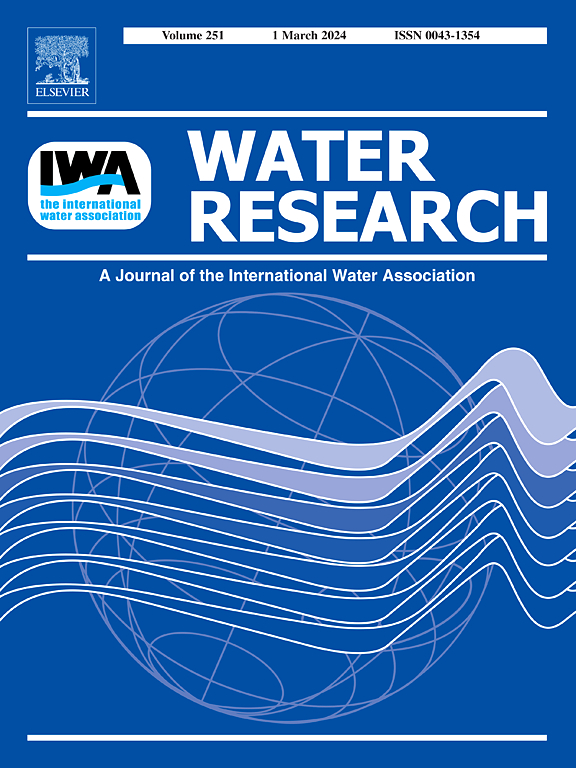通过提高活性污泥微生物群落胞外聚合物质的产生将氧诱导氧化应激与资源回收联系起来
IF 12.4
1区 环境科学与生态学
Q1 ENGINEERING, ENVIRONMENTAL
引用次数: 0
摘要
随着全球向循环废水处理过渡的加剧,细胞外聚合物(EPS)已成为资源回收的重要目标。尽管大多数相关的努力都集中在好氧颗粒污泥上,但占全球废水处理大部分的传统活性污泥系统仍未得到充分利用。基于氧化应激与纯菌株EPS生物合成之间的联系,研究人员提出,通过有策略地控制氧暴露模式来增强活性污泥微生物群落的氧化应激,可以提高EPS的产量。为了验证这一点,本研究在有氧暴露下应用连续氧扰动来增强氧化应激。与模拟典型废水曝气的稳定氧条件相比,扰动显著提高了EPS产率,达到74.4 mg/L/day,比稳定条件(39.0 mg/L/day)提高了90.5%。为了验证氧化应激对EPS增强的作用,在扰动模式中引入间歇缺氧期来缓解氧化应激,使EPS增强效果消失,产量降至9.8 mg/L/d。在机制上,在有氧持续扰动下,氧化应激的加剧主要是由非呼吸性黄酮酶的还原底物升高驱动的,例如谷氨酸合成酶、谷胱甘肽还原酶和二氢脂酰胺脱氢酶,这些酶容易产生H2O2作为一种意想不到的代谢副产物。在产生H2O2的微生物类群中,Methylophilaceae、Comamonadaceae和Rhodobacteraceae同时表现出EPS生物合成蛋白的上调,这表明这些科的类群共同介导了H2O2的产生和EPS的增强。通过调节曝气,本研究提供了一种无化学物质、可控的策略来提高传统活性污泥系统中EPS的产量。本文章由计算机程序翻译,如有差异,请以英文原文为准。


Linking oxygen-induced oxidative stress to resource recovery by enhancing the production of extracellular polymeric substances in activated sludge microbial communities
As the global transition toward circular wastewater treatment intensifies, extracellular polymeric substances (EPS) have emerged as valuable targets for resource recovery. Although most related efforts have focused on aerobic granular sludge, conventional activated sludge systems, which account for most global wastewater treatment, remain underexploited. Building on the established link between oxidative stress and EPS biosynthesis in pure strains, it is proposed that strategically manipulating oxygen exposure patterns to intensify oxidative stress in activated sludge microbial communities could enhance EPS production. To test this, this study applied continuous oxygen perturbation under aerobic exposure to intensify oxidative stress. Compared to a stable oxygen condition simulating typical wastewater aeration, the perturbation considerably enhanced EPS yield to 74.4 mg/L/day, a 90.5 % increase over the stable condition (39.0 mg/L/day). To validate the role of oxidative stress in EPS enhancement, intermittent anoxic phases were introduced into the perturbation pattern to relieve oxidative stress, causing the EPS-enhancing effect to disappear, with yield dropping to 9.8 mg/L/day. Mechanistically, intensified oxidative stress under aerobic continuous perturbation was primarily driven by elevated reducing substrates for non-respiratory flavoenzymes, exemplified by glutamate synthase, glutathione reductase, and dihydrolipoamide dehydrogenase, which are prone to generate H2O2 as an unintended metabolic byproduct. Among the multiple microbial groups contributing to H2O2 production, Methylophilaceae, Comamonadaceae, and Rhodobacteraceae were distinguished by simultaneously exhibiting upregulation of EPS biosynthesis proteins, suggesting that taxa within these families collectively mediated both H2O2 production and EPS enhancement. By modulating aeration, this study offers a chemical-free, controllable strategy for enhancing EPS production within conventional activated sludge systems.
求助全文
通过发布文献求助,成功后即可免费获取论文全文。
去求助
来源期刊

Water Research
环境科学-工程:环境
CiteScore
20.80
自引率
9.40%
发文量
1307
审稿时长
38 days
期刊介绍:
Water Research, along with its open access companion journal Water Research X, serves as a platform for publishing original research papers covering various aspects of the science and technology related to the anthropogenic water cycle, water quality, and its management worldwide. The audience targeted by the journal comprises biologists, chemical engineers, chemists, civil engineers, environmental engineers, limnologists, and microbiologists. The scope of the journal include:
•Treatment processes for water and wastewaters (municipal, agricultural, industrial, and on-site treatment), including resource recovery and residuals management;
•Urban hydrology including sewer systems, stormwater management, and green infrastructure;
•Drinking water treatment and distribution;
•Potable and non-potable water reuse;
•Sanitation, public health, and risk assessment;
•Anaerobic digestion, solid and hazardous waste management, including source characterization and the effects and control of leachates and gaseous emissions;
•Contaminants (chemical, microbial, anthropogenic particles such as nanoparticles or microplastics) and related water quality sensing, monitoring, fate, and assessment;
•Anthropogenic impacts on inland, tidal, coastal and urban waters, focusing on surface and ground waters, and point and non-point sources of pollution;
•Environmental restoration, linked to surface water, groundwater and groundwater remediation;
•Analysis of the interfaces between sediments and water, and between water and atmosphere, focusing specifically on anthropogenic impacts;
•Mathematical modelling, systems analysis, machine learning, and beneficial use of big data related to the anthropogenic water cycle;
•Socio-economic, policy, and regulations studies.
 求助内容:
求助内容: 应助结果提醒方式:
应助结果提醒方式:


